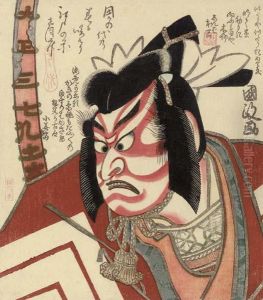Utagawa Kunimasa Ii Paintings
Utagawa Kunimasa II, originally born as Bunko Matsuura in 1773, was a notable ukiyo-e artist in Japan, particularly recognized for his kabuki theater prints. His career was deeply rooted in the rich tradition of the Utagawa school, one of the most influential schools in the history of Japanese woodblock printing. Kunimasa II was initially a student of Utagawa Toyokuni I, under whose guidance he honed his skills and developed his distinctive style. Utagawa Toyokuni I was a prominent master in the Utagawa school, and his mentorship played a crucial role in shaping Kunimasa II's artistic path.
Kunimasa II's work primarily focused on yakusha-e, or actor prints, depicting scenes and characters from kabuki theater. These prints were highly popular during the Edo period as they captured the vibrant and dynamic essence of contemporary theater culture. Through his detailed and expressive portrayals, Kunimasa II was able to convey the drama and emotion of kabuki performances to the broader public. His ability to capture the likeness and spirit of actors made his prints cherished among theater enthusiasts and collectors.
Despite his talent and contributions to the ukiyo-e genre, Kunimasa II's career was relatively short-lived. He passed away in 1810, leaving behind a modest but impactful body of work. His legacy, though not as widely recognized as some of his contemporaries or successors in the Utagawa school, remains significant for scholars and enthusiasts of ukiyo-e. Kunimasa II's prints continue to be appreciated for their beauty, craftsmanship, and insight into the cultural and theatrical practices of Edo-period Japan. His work not only provides a glimpse into the world of kabuki but also contributes to the broader understanding of the period's artistic and cultural expressions.
